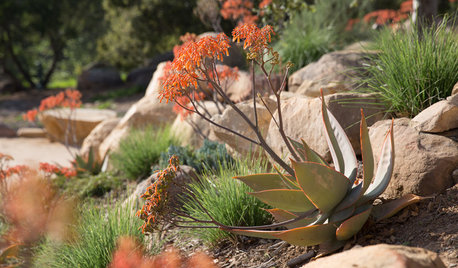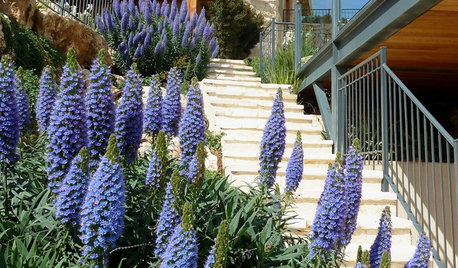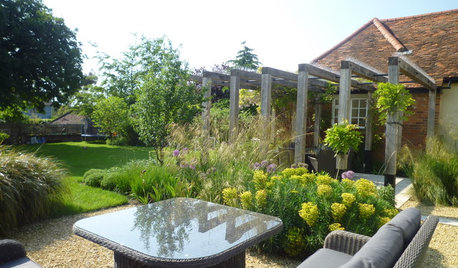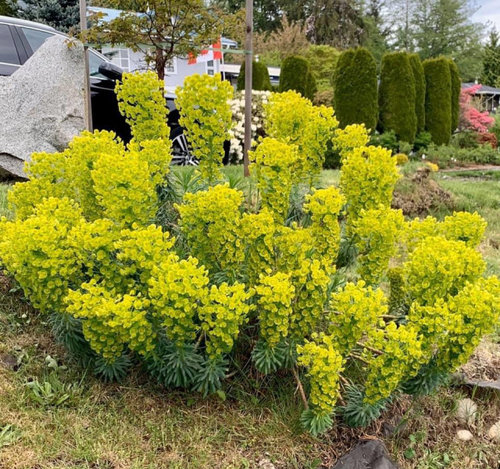Euphorbia Characias Wulfenii help
WestCoast Hopeful
3 years ago
Related Stories

INSPIRING GARDENSInside Houzz: A Waterfront Property Ditches the Grass for a Garden
New drought-tolerant plantings and outdoor gathering spaces help this California backyard take in the view without wasting space or water
Full Story
GARDENING GUIDESHow to Grow a Flower Garden for Bouquets
Enjoy fresh blooms indoors, bring beauty and fragrance to your garden beds, and help support pollinators
Full Story
PLANTING IDEASPlant These Garden Favorites for a Taste of the Mediterranean
These 8 gorgeous and fuss-free plant combinations evoke the style of the region, villa not included
Full Story
PATIO OF THE WEEKModern Curves Grace a California Backyard
A tiered entertaining patio and new plantings root a music studio in the landscape of this multiuse space
Full Story
LANDSCAPE DESIGNPatio of the Week: Design Details and Lush Plantings
A landscape designer found on Houzz transforms a tiny space into an inviting multiuse outdoor living room
Full Story
PLANTING IDEASHow to Make Your Driveway Part of Your Garden
Spruce up the borders along your drive to create a welcoming arrival to your home
Full Story
GARDENING GUIDES9 Self-Seeders Capture Chelsea Flower Show Magic
Give your garden show-worthy style with these plants beloved by top designers
Full Story
FALL GARDENING7 Inspiring Western Landscapes With Fall Color for Dry Climates
Designers use succulents, ornamental grasses and low-water shrubs and trees for rich fall tones in water-wise gardens
Full Story
GARDENING GUIDESGreat Design Plant: Pride of Madeira
Try this drought-tolerant stunner for its massive flower spikes that burst with purple, drawing butterflies and birds to the garden
Full Story
LANDSCAPE DESIGNTour a 4-Season English Garden Designed for Outdoor Living
An elegant courtyard with multiple destinations to discover encourages a family to enjoy the outdoors
Full Story









Susie Potgieter
WestCoast HopefulOriginal Author
Related Professionals
Avocado Heights Landscape Contractors · Cincinnati Landscape Contractors · El Reno Landscape Contractors · Sun Valley Landscape Contractors · Morton Grove Interior Designers & Decorators · West Jordan Architects & Building Designers · Milwaukee Furniture & Accessories · Toledo Furniture & Accessories · Ives Estates Furniture & Accessories · Urbandale Furniture & Accessories · Bel Air General Contractors · Bloomington General Contractors · Burlington General Contractors · Groton General Contractors · Jacksonville General Contractorsgahnoc
Embothrium
BeverlyFLADeziner
gardengal48 (PNW Z8/9)
WestCoast HopefulOriginal Author
gardengal48 (PNW Z8/9)
WestCoast HopefulOriginal Author
Susie Potgieter
gardengal48 (PNW Z8/9)
WestCoast HopefulOriginal Author
gardengal48 (PNW Z8/9)
WestCoast HopefulOriginal Author
Embothrium
WestCoast HopefulOriginal Author
gardengal48 (PNW Z8/9)
WestCoast HopefulOriginal Author
gardengal48 (PNW Z8/9)
WestCoast HopefulOriginal Author